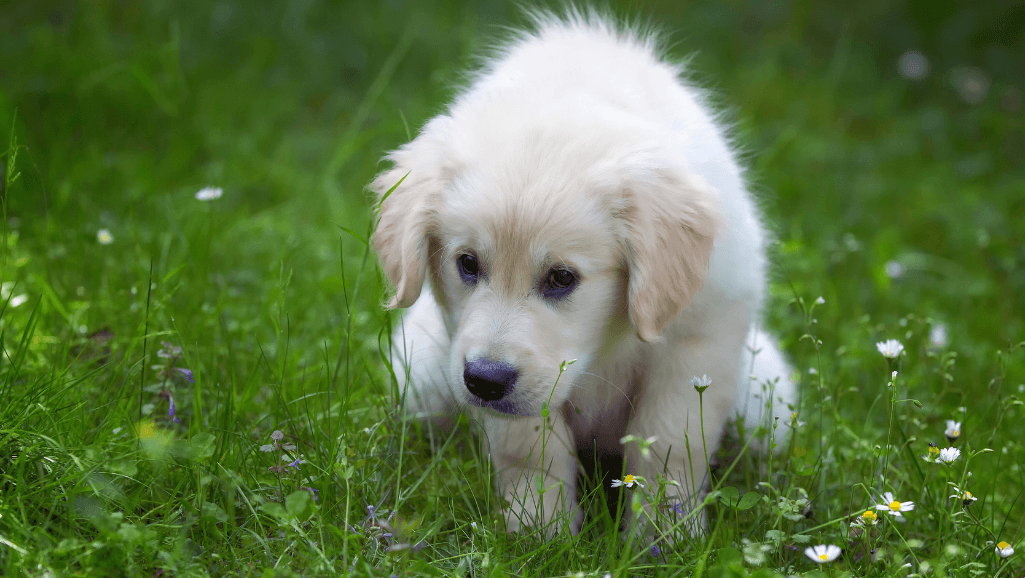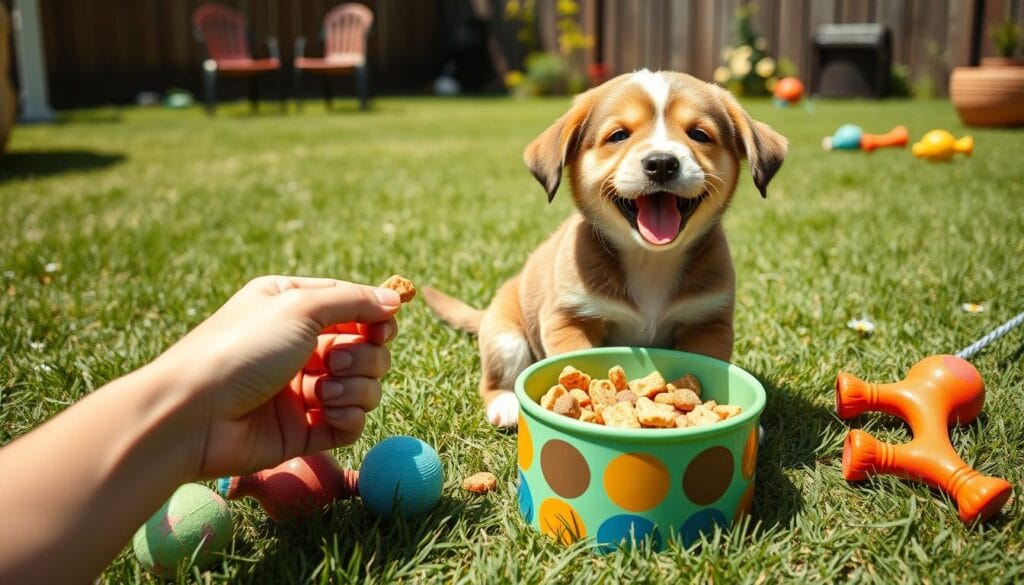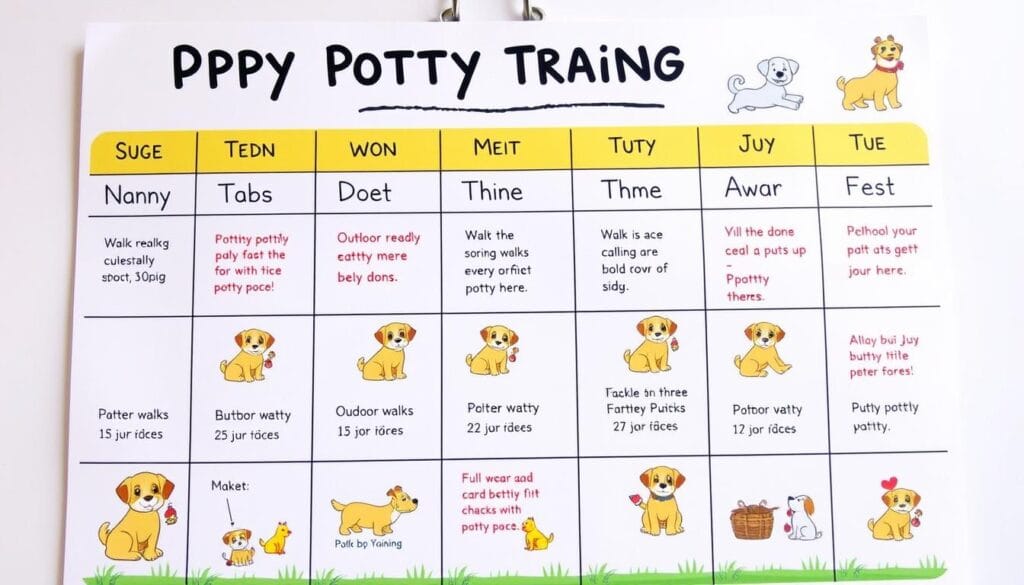Are you a new puppy parent wanting to house train your furry friend fast? You can potty train your puppy in just 7 days with the right steps. This quick guide will show you how to establish a routine and use positive reinforcement.
Consistency and patience are key for house training puppies. Puppies under 12 weeks need to go out every 1 to 2 hours because their bladder control is limited. Puppies can hold their urine for one hour per month of age.
By setting a regular feeding schedule and taking your puppy out often, especially after waking up, eating, or playing, you help them learn where and when to go potty.
Crate training is a helpful tool in potty training. A crate provides a safe space for your puppy to hold it until you take them outside. But, it’s important not to leave your puppy in the crate for too long.
Positive reinforcement is key in training your puppy to use pee pads or go outside. Give your puppy treats, praise, and enthusiastic words when they go in the right place. Following a consistent schedule and using positive reinforcement can help most puppies learn to go potty in 7 to 14 days.
Key Takeaways
- how to toilet train a puppy in 7 days
- Consistency and patience are crucial for successful puppy potty training
- Take puppies under 12 weeks outside every 1-2 hours
- Establish a regular feeding schedule to help regulate bathroom routines
- Use positive reinforcement techniques, such as treats and praise
- Most puppies can be reliably house trained within 7-14 days with consistent effort
Preparing for Puppy Potty Training Success
Before starting the 7-day puppy potty training plan, prepare your home and gather needed items. Puppy proofing your home is key to keep your pet safe and prevent accidents. Remove hazards like electrical cords, toxic plants, and small objects that your puppy might chew or swallow.
Essential Equipment for House Training a Puppy
To help your puppy succeed, you’ll need certain items:
- Collar or harness and leash
- Puppy training pads or pee pads
- Enzymatic cleaner for accidents
- Puppy potty rewards, such as treats or praise
- Crate or playpen for confinement
- Puppy potty bells to signal the need to go outside
Setting Up a Designated Potty Area
Choose a spot in your yard or balcony for your puppy to go. It should be easy to get to and away from busy areas. If you live in an apartment or don’t have a yard, use puppy pee pads or a dog litter box indoors.
Consistency is key when it comes to potty training. Take your puppy to the designated area every time they need to go, and use a specific cue word or phrase, such as “go potty,” to help them associate the action with the command.
Establishing a Consistent Feeding and Toilet Schedule
Puppies do well with routine, especially when it comes to eating and going to the bathroom. Feed your puppy at regular times, like two to three meals a day, based on their age and breed. Remove any leftover food after 20 minutes to prevent overeating and keep track of when they eat.
Take your puppy to the potty area every 30 minutes to an hour, after meals, naps, and play. Puppies under three months need to go out every hour when awake. As they get older and their bladder control improves, you can wait longer between potty breaks.
Keep a record of your puppy’s potty habits, including the times they eliminate and any accidents that occur. This will help you identify patterns and plan your potty breaks accordingly. By setting up a designated potty area, establishing a consistent routine, and using the right equipment, you’ll lay the foundation for a successful puppy potty training experience.
Understanding Your Puppy’s Potty Signals and Habits
To toilet train your puppy in 7 days, knowing their potty signals is key. Puppies show signs like sniffing, circling, and whining when they need to go. Recognizing these signs helps you take them to the right spot, avoiding accidents.
Watching your puppy closely helps you learn their potty habits. They often need to go after waking up, eating, or playing. Feed them three small meals a day and take them out every 45 minutes when awake. As they get used to it, you can wait longer between potty breaks.
Puppies are usually fully potty trained by about nine months of age, but it’s best to begin toilet training between 8 and 16 weeks old for optimal results.
Keeping a record of your puppy’s potty habits is important. Note when and where they go to help predict their needs. Start with short potty breaks every 30-60 minutes for young puppies. As they get more comfortable, you can extend the time outside.
- Supervise your puppy closely and redirect them to the designated potty area if needed.
- Use puppy pads initially to help manage accidents and maintain cleanliness.
- Gradually introduce your puppy to outdoor potty areas, limiting initial visits to no more than 5 minutes.
Understanding your puppy’s potty signals and habits helps you guide them well. Consistent rewards for good potty behavior will help them learn fast. This way, you can house train them in just 7 days.
Effective Puppy Potty Training Techniques
Potty training your puppy is a big step in their growth. It needs patience, consistency, and the right methods. By using good potty training techniques, you can teach your puppy where and when to go. This makes life easier for both you and your puppy. Here are some key strategies for success in potty training your puppy.
Positive Reinforcement and Reward-Based Training
Positive reinforcement is a powerful tool in puppy training. When your puppy goes potty in the right place, praise them, give treats, or toys. This makes them link going potty in the right spot with good things, encouraging them to do it again. Use puppy potty training treats that are small, easy to digest, and very appealing to your puppy.
Using Crate Training to Aid in House Training
Crate training is a great way to house train puppies. Dogs naturally want to keep their sleeping area clean, so they’re less likely to soil their crate. Pick a crate that’s just the right size for your puppy to stand, turn around, and lie down comfortably. When you can’t watch your puppy, put them in the crate to prevent accidents and keep a routine. Remember, puppies can hold their bladder for about one hour for every month of age, so give them lots of potty breaks.
Implementing a Consistent Potty Break Routine
Consistency is key in puppy toilet training. Set a regular schedule for meals, playtime, and potty breaks. Take your puppy outside in the morning, after meals, naps, and play, and before bed. Puppies usually need to go potty 10-15 minutes after eating or drinking, so be ready to take them out then. Most puppies can sleep for about seven hours without needing to go, but watch for their signs and adjust the schedule as needed. A consistent routine helps your puppy learn to control their elimination habits.
Persistence and consistency in your puppy’s potty training routine can lead to success in as little as a few weeks. Stay patient, use positive reinforcement, and watch for your puppy’s unique signals to make the process as smooth as possible.
By using these effective puppy potty training techniques every day, you’ll be on your way to a happy, well-trained pup. Remember, every puppy is different, so be patient and adjust your approach as needed for the best results for you and your furry friend.
Dealing with Puppy Potty Training Challenges and Setbacks
Even with the best plans and a puppy potty training schedule, accidents can happen. Remember, these mishaps are part of your puppy’s learning. Being consistent, patient, and positive is key to overcoming setbacks and ensuring your puppy’s success in house training.
Handling Accidents and Cleaning Up Messes
When accidents happen, clean the area well with an enzymatic odor remover. These cleaners break down urine and feces proteins, neutralizing scents and preventing your puppy from returning. It’s important to clean thoroughly to avoid attracting your puppy back to the same spot.
Don’t punish your puppy for accidents. Yelling or rubbing their nose in the mess can cause fear and confusion. Instead, reward them when they use the potty area correctly, and clean up quietly without making a big deal about the accident.
Overcoming Common Puppy Potty Training Obstacles
Inconsistency, lack of supervision, and too much freedom too soon are common challenges. To overcome these:
- Follow a regular feeding and potty break schedule to create a predictable routine for your puppy.
- Keep a close eye on your puppy, especially during playtime and after meals, to prevent accidents and quickly redirect them to the designated potty area when necessary.
- Gradually increase your puppy’s access to new areas of the house as they demonstrate reliability in their potty habits. Use baby gates or close doors to limit their access to unsupervised spaces.
Patience, consistency, and positive reinforcement are the cornerstones of successful puppy potty training. By focusing on these principles and addressing challenges as they arise, you’ll be well on your way to helping your furry friend develop reliable house training habits.
Every puppy is different, and some may take longer to learn. Stay committed, celebrate successes, and trust that with time and dedication, your puppy will become a well-trained and cherished member of your household.
How to Toilet Train a Puppy in 7 Days: A Step-by-Step Guide
Toilet training a puppy can seem tough, but it’s doable with the right steps. You can potty train your puppy in just 7 days. This guide will show you how to do it easily, making it stress-free for both you and your puppy.
Day 1: Introducing the Designated Potty Area and Schedule
Start by showing your puppy their potty spot. Pick a place in your yard or on a puppy pad. Take them there every 30 minutes to an hour, saying “go potty” to help them.
Puppies under 12 weeks need to go more often because their bladders are small. Also, feed them three times a day at the same time. This helps their digestive system and makes it easier to know when they need to go.
Days 2-4: Building a Consistent Routine and Rewarding Success
Next, create a routine for potty training. Take your puppy to their spot after waking up, before bed, after meals, and after play. Watch for signs they need to go, like sniffing or circling.
When they go in the right spot, praise them, give treats, and play. Positive rewards help them learn to go in the right place.
Verbal cues like ‘toilet’ can be associated with the correct behavior when the dog goes to the bathroom in the right spot, followed by immediate rewards such as praise, treats, and playtime.
Days 5-7: Gradually Extending Time Between Potty Breaks
As your puppy gets better, you can wait longer between potty breaks. Dogs can hold their urine for one hour more than their age in months. For example, an 8-week-old puppy can hold it for about three hours.
Keep watching your puppy and reward them for good behavior. If they have an accident, clean it up with a warm solution of biological washing powder. This removes the smell and stops them from going there again.
By the end of 7 days, your puppy should know how to go to the bathroom in the right place. Remember, being consistent is key. Most puppies can learn to go to the bathroom outside in one to two weeks with a good routine and positive rewards.
Troubleshooting Common Puppy Potty Training Issues
Even with the best plans, puppy potty training problems can happen. Puppies might have accidents, go in their crate, or not go where they should. Remember, most puppies can learn to go potty in 4 to 6 months. But, smaller dogs might take longer because their bladders are smaller.
If your puppy has accidents or goes in their crate, check for health issues first. See your vet for problems like bladder inflammation or infections. After that, make sure your training routine is consistent.
Puppies rely on their owners for bathroom breaks. They can hold their bladder for about an hour for each month of age. So, an 8-week-old puppy might need to go every hour or two. But, if they don’t go outside in 5 minutes, they might not need to go then.
To fix housebreaking issues, try these tips:
- Clean accidents well with an enzymatic cleaner. Dogs smell 10,000 times better than humans.
- Use sprays to help your puppy go in the right place.
- Change your schedule as needed. Take your puppy out after play, naps, eating, or drinking.
- Feed your puppy small meals three times a day. This helps their immature digestive system.
- Give treats and praise when your puppy goes potty outside.
Remember, being consistent and patient is crucial. If problems don’t go away, get help from a professional trainer or behaviorist.
By quickly and effectively solving common potty training issues, you can avoid bigger problems. With commitment and a steady routine, you and your puppy will master potty training.
Transitioning to Outdoor Potty Training for Puppies
When your puppy is reliable with indoor potty training, it’s time to move to outdoor potty training. This step usually starts after your puppy has had all their vaccinations and is a bit older. Remember, being consistent and patient is key for successful outdoor puppy potty training. You’ll need to watch your puppy closely and guide their behavior when needed.
Introducing Your Puppy to Outdoor Potty Areas
Start by showing your puppy a special potty area outside. Use the same command you used indoors, like “go potty” or “do your business.” Give your puppy praise and treats right after they go outside to encourage good behavior.
To help your puppy connect going outside with potty time, place the puppy pad near the door. This teaches them that going outside is the goal. Remember, different breeds might need more or less potty breaks because of their size and metabolism.
Supervision is key when starting outdoor potty training. If you can’t watch your puppy, keep them in a crate or small room to avoid accidents.
Teaching Your Puppy to Signal When They Need to Go
Teaching your puppy to signal when they need to go can make outdoor potty training better. You can use a bell near the door for them to ring when they need to go out. Always take your puppy out when they ring the bell and reward them for going outside.
Puppies can hold their bladder for as long as their age in months plus one hour. So, make sure to give them potty breaks often, especially after waking up, eating, playing, and napping. If they don’t go when taken outside, put them back in their crate for a bit before trying again.
- Use the same word or phrase to encourage elimination outdoors
- Reward your puppy immediately after they successfully eliminate outside
- Gradually increase the time between indoor and outdoor potty breaks
- Teach your puppy to signal when they need to go using a bell or other method
Conclusion
Housebreaking a puppy can take 4 to 6 months. But, using the right tips can speed up the process. Start training between 12 and 16 weeks, as puppies learn fast then.
Consistency and routine are crucial. Positive reinforcement is key to success. This means rewarding your puppy for good behavior.
Feed your puppy small meals often and take them out every 30 minutes. A house crate helps with training. If accidents happen, clean up calmly and don’t scold.
Give treats after successful potty breaks. This encourages good behavior. It’s important to be patient and consistent.
Trying to train a puppy in just seven days is too hard. It usually takes a few weeks to a couple of months. Consistency among household members helps puppies learn faster.
As your puppy grows, they’ll sleep through the night by 5-6 months. Stay patient, consistent, and positive. You’ll have a house-trained puppy in no time.






















